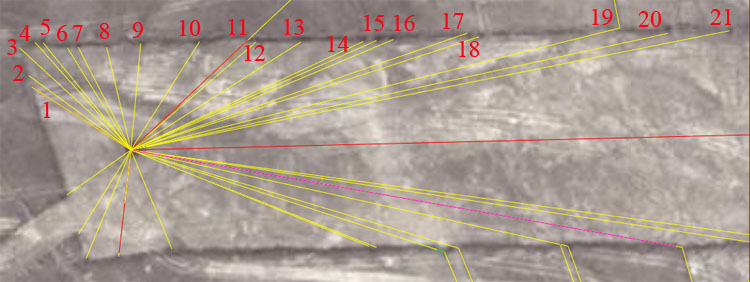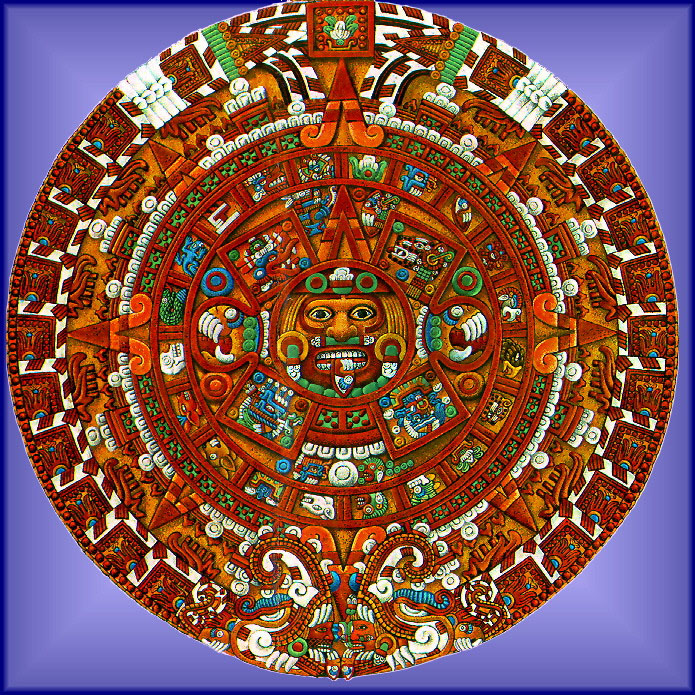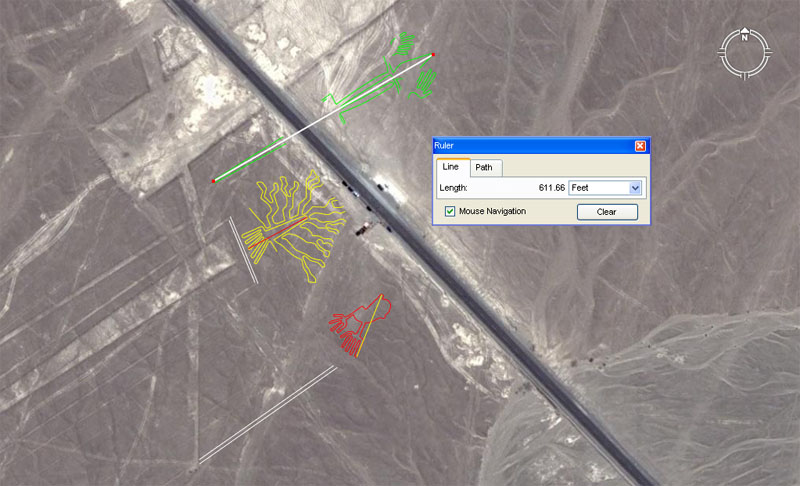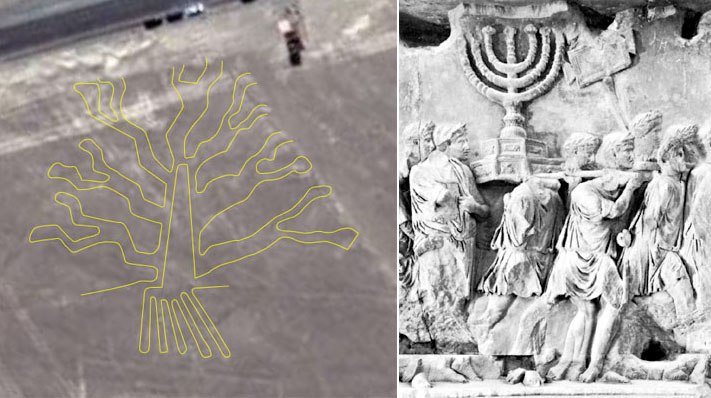

1. The distance is 115.2-feet and the angle is 302.4-degrees.
The 115.2 mathematical progression has already been discussed as one of the foremost of those used in antiquity. It provides dynamic numbers used in navigation.
The degree angle in this instance is coding the perimeter value of the Great Pyramid, which is 3024-feet for 1/2 of 1-minute of arc.
2. The distance is 124.416-feet and the angle is 126-degrees return to the cairn.
The distance is coding half the equatorial circumference of the Earth (12441.6-miles). Within this distance it's almost obligatory that both 125-feet and 126-feet (120 Greek feet or 12 Hebrew Reeds) would have been included and that the line was triple coded.
The 126-degree return angle is one of the most dynamic of antiquity, as already discussed.
3. The distance is 148.5-feet and the degree angle from the cairn to the outermarker is 312.5-degrees.
Values like 148.5-feet or 356.4-feet are divisible by both 6 & 11 and appear to have been used as calibrations for circles, where the diameter was based upon a lunar value. Thus 472.5 (16 X 29.53125 or 16 lunar months in days) X PI @ 22/7 (3.1412857143) = 1485 (135 X 11 or 247.5 X 6). Calibrated disks made to this formula could have tracked the separate lunar counts or cycles within a circuit based upon 11 or 6. The ancient astronomer-navigators were very adept and well-trained mathematicians who could reduce everything to factorable numbers and track spans of time or distance on calibrated circles.
The angle is 312.5 and there were 3.125 miles of 5280-feet each in the ancient British league of 16500-feet. The value of 3.125 was yet another form of PI for easily converting diameters to circle circumferences. The true diameter of the Earth, for example, is 7920-miles of 5280-feet each. If this diameter is multiplied by 3.125 (as an approximate expression of PI), then the result is 24750-miles. This value was the second, alternative or symbolic reading of the Great Pyramid's length under the "11" family of numbers as 756.25-feet of length, resulting in 1-minute of arc (8-side lengths) being 6050-feet, instead of 6048-feet under the Great Pyramid's literal system. Therefore, 6050-feet X 60 = 1-degree of equatorial arc (363000-feet) X 360-degrees = 130680000-feet ÷ 5280 (British mile) = 24750-miles.
4. The distance is 141.75-feet and the angle is 138.24-degrees.
The 141.75-feet is a lunar code and a progression based upon this value goes: 141.75, 283.5 (note: the Khafre Pyramid @ 708.75-feet per side was 2835-feet in perimeter value), 425.25, 567, 708.75 (side length of Khafre), 850.5, 992.25, 1134 ... 1701, ...2268, ... 2551.5 (note: the lunar count within the Sabbatical Calendar system was 2551.5-days from the mistletoe culling ceremony), etc. Values for the length of the lunar year or lunar nutation cycle occur within this progression.
The angle of 138.24-degrees is a navigational mathematical progression that provides values for the equatorial size of the Earth. It goes: 138.24, 276.48, 414.72, 552.96, 691.2 (note: in a world with an equatorial circumference of 24883.2-miles, the sum of 69.12-miles would be 1-degree of arc), 829.44, 967.68, 1105.92, 1244.16 (note: half the equatorial circumference of the Earth would be 12441.6-miles), etc.
5. The distance is 136.08 and the return angle back to the cairn is 140.625-degrees.
The value of 136.08-days would be 1/50th of the 6804-day Lunar Nutation cycle.
The angle of 140.625 (140 & 5/8ths) is important in navigation. There would be 176 increments of 140.625-miles (742500-feet) in the 24750-mile circumference of the Earth. There would be 256 X 1.40625-degrees in 360 degrees. A mathematical progression based upon this value delivers up numbers that relate directly to a 360-degree circuit simultaneously to lunar cycle numbers. There would be 2.1 intervals of 14.0625-days in a lunar month or 25.2 in a lunar year. This way of looking at things mathematically provided yet another option in calculating cycles or divisions within circles. The ancient mathematician-astronomers used every factorable number available (harmonic values), in all of the separate number families. A parallel could be drawn to a modern jazz musician, who memorises every conceivable scale, harmonic or chord family interrelationship, in order to improvise on an instrument confidently and move between a large range of scales without audible discordance.
6. The distance is 118.125-feet and the angle is 328.125-degrees.
The distance is coding 4 lunar months of 29.53125-days each. The increment of 118.125-feet was integral to the 3,4,5 triangle concept by which the Khafre Pyramid (Egypt's Pyramid of the Moon) was built. Half the base length (adj.) was 354.375-feet (3 X 118.125-feet), the height (opp.) was 472.5-feet (4 X 118.125-feet) and the diagonal slope of the faces (hyp.) was 590.625-feet (5 X 118.125-feet).

The so-called Aztec Calendar or Sunstone, dug up on December 17th 1760 in Mexico City during renovations to a cathedral. It has an official diameter of 3.60 metres, which measurement is stated in scientific publications like National Geopgraphic Magazine. The sum of 3.60 metres equals 11.8125-feet to a tolerance of about 1/56th of an inch (less than half a milimetre). The circumference code, using PI @ 22/7ths , is 37.125-feet or 445.5-inches, which is a strong navigational code when viewing the Earth's equatorial circumference as 24750-miles.
The angle of 328.125-degrees sets up a mathematical progression that is lunar as well. It goes: 328.125, 656.25, 984.375, 1312.5, 1640.625, 1968.75 (note: the Egyptian & Roman Beqa gold standard weight was 196.875-grains), 2296.875, 2625 (note: a Greek mile is 5250-feet or 2625-feet X 2), 2953.125 (note: the lunar month is 29.53125-days), etc.
7. The length is 113.4-feet and the angle is 152.777777-degrees (152 & 7/9ths). The angle can also be read as 152. 742857143 (15274 & 2/7ths ÷ 100).
The length code sets up a lunar mathematical progression that goes 113.4 (note: the Great Pyramid's side length in inches is 9072 or 113.4-inches X 80), 226.8 (note: 3-sides of the Great Pyramid @ 756-feet per side = 2268-feet), 340.2 (note: the perimeter value of the Khafre Pyramid @ 708.75-feet per side is 34020-inches), 453.6 (note: the Great Pyramid has a vertical height of 453.6-feet to the top of its altar floor), 567, 680.4 (note: the lunar nutation cycle endures for 6804-days), etc. All of these values are highly important to lunar, navigational and calendar calculations. It's worthy to note that the Station Stone's rectangle at Stonehenge has a design width of 113.4-feet.
The degree angle code is of tremendous importance to the Roman mile and the Roman adopted method of navigation at sea. Here's how it worked:
Under this ancient system that the Romans later adopted, a circuit based upon 35640 calibrations within 360-degrees, for increments ranging up to 99 within each degree seems to have been employed. Alternatively the navigator could have used a circuit based upon 32400 calibrations in 360-degrees for increments in the range of 90 per degree of arc. Another option included the value 39600 for increments set to 110 calibrations per degree of arc, etc. Other compass circuits based upon 640, 630 and 320 seem to have been employed, depending on the kind of cyclic monitoring going on. Another method was to multiply a "7" based value by the ratio 1: 1.75...thus 15274.2857143 (4860 X 22/7) X 1.75 = 26730 or 74.25-feet (a much used navigational value) per degree of arc.
Moreover, the Roman navigator, using his own mile of 5000 Roman feet, could adapt this system to suit other navigational methods. For example:
There were yet other "slightly rounded" expressions of PI that gave whole number readings, which would have been useful in teaching concepts to initiate students. For example:
We have to keep it in the forefront of our minds that the ancient navigators were obliged to use very manual systems of calculation and had to commit many mathematical concepts to memory. Apart from string-knot (quippu) or abacus recording & calculation devices, they would have memorised concepts by rote, repetition, practice, song, poetry, stories or cadence rhythms and chants. All of the numbers and methods had to be very well learnt and deeply embedded for immediate retrievable on demand, as civilisation and the ability to travel safely on the great oceans depended on that hard-won, precious knowledge.
8. The distance is 103.68-feet and the angle back to the cairn is 166.66666-degrees (166 & 2/3rds).
The distance value was of great significance to ancient astronomers and navigators. Remember that the true equatorial size of the Earth was considered to be 12 X 12 X 12 X 12 X 1.2-miles of 5280-feet each or 24883.2-miles. This very factorable means of describing the circumference is only 18.8-miles less than the official value we use today of 24,902-miles. So, if the Earth is 24883.2, then its rate of rotation in MPH must be 24883.2 ÷ 24-hours = 1036.8 miles per hour. The length of the coffer in the Khafre Pyramid was measured by Petrie to be 103.68-inches. The "Stirling Jug" of Scotland had a capacity of 103.68 cubic inches and this paralleled the Jerusalem Liquid Standard of the ancient Hebrews, wherein a "Cab" was 103.68-cubic inches. Also, the value 103.68-feet is two times 51.84. The slope angle of the Great Pyramid was designed to be 51.84-degrees. Alternatively, each side length of the Great Pyramid (756-feet) is 72 Reeds of 10.5-feet each. This means that the base area that the Great Pyramid covers is 72 X 72 Reeds = 5184. In navigation using the "11" family of numbers, a British league (16500-feet or 3.125-miles) of diameter creates a circle of 518400-feet using PI @ 3.141818182 (314 & 2/11ths ÷ 100). Using this rendition of PI on diameters based upon the number "11" will create circumferences divisible by 360-degrees. An example of this is 7920-miles (the Earth's true diameter) X 3.141818182 = 24883.2-miles.
The degree angle carries a ratio code (in an increased denomination) that was integral to the 3,4,5 triangle. By the 3,4,5 triangle squaring method the Opposite is always 1.25 less than the Hypotenuse and the Adjacent is always 1.6666666 less than the Hypotenuse. This is the geometric method by which the Khafre Pyramid of Egypt was built.
9. The distance is 105-feet and the angle from the cairn to this position is 52.5-degrees.
The distance is simply coding one Hebrew Reed or 1/500th of a Greek mile.
The angle is similarly coding increments within the Greek system of measurement. The Greek "Short-stadia" was 525-feet and the Greek mile was 5250-feet. It is thought by this researcher that the ancient Druidic staffs were probably 5.25-feet long and based upon half a Reed measurement. With such a calibrated staff, the Druids could work out the exact position of both the sun and the moon within the Sabbatical Calendar system, by which means the could conveniently count both solar and lunar periods in increments of 5.25-days (126-hours).
10. The distance is 126-feet and the angle is 32.4-degrees.
The distance is 12 Hebrew Reeds.
The angle provides a base value for a very important mathematical progression, which goes: 32.4, 64.8, 97.2 (navigation), 129.6 (Precession), 162 (rounded PHI), 194.4 (navigation). 226.8 (lunar), 259.2 (Precession), 291.6 (navigation), 324 (navigation), 356.4 (navigation), etc.
11. The distance is 157.5-feet and the angle is 22.68-degrees from this outer station back to the cairn.
The length is dual coded and means 1/4th of a Greek stadia (630-feet) or 15 Hebrew Reeds, simultaneously to meaning 157.08-feet or a value indicating 1/2 PI (1.5708).
The angle code (226.8-degrees) is both a navigational and strong lunar code simultaneously. Three sides of the Great Pyramid @ 756-feet per side = 2268-feet. The Lunar nutation cycle of 6804-days duration, which at every stage of its lunar passage is effecting our weather patterns in different ways, needed to be monitored with great care on a daily basis. One third of the 6804-days is 2268-days.
12. The distance is 162-feet and the angle back to the cairn is 229.16666-degrees (229 & 1/6th).
The distance is coding "rounded" PHI @ 1.62. The true PHI ratio (1: 1.6180339) was a difficult, unresolvable number like PI, so many ancient edifices were built to a slightly round form of PHI where the dimensions could be read symbolically to pure PHI values simultaneously to rounded PHI values.. Therefore the Great Pyramid @ 756-feet equates to 466.66666 X 1.62 (466 & 2/3rds). Alternatively, the Khafre Pyramid complies to 437.5 X 1.62-feet. The same modus operandi was applied to reading the Great Pyramid in rounded PI (3.15) values and there would be 240 X 3.15-feet in the Pyramid's length. Alternatively, the Khafre Pyramid was 225 X 3.15-feet in length. In a reading of the Great Pyramid in PI @ 22/7 there would be 240 X 3.12857143-feet = 754.2857143 (754 & 2/7ths) which is 1/7th of a mile @ 5280-feet.
The degree angle code is simply a part of a navigational progression that runs: 229.166666, 458.33333, 687.5, etc. Note: under the Great Pyramid's second geodetic system that viewed the Earth as 24750-miles, 68.75-miles was 1-degree of arc.
13. The distance is 198-feet and the angle is 57.6-degrees from the cairn to this outlying position.
The distance is very important to navigation using the "11" family of numbers. A mathematical progression based upon 198 goes: 198, 396, 594, 792 (the diameter of the Earth is 7920-miles), 990, etc... all the way to 13068 (the number of feet in the equatorial circumference is 130680000 under the Great Pyramid's secondary reading of 756.25-feet per side for 1/8th of 1-minute of arc...24750-miles).
The vertical height of the Great Pyramid was 453.6-feet, but the side length up the diagonal face was coded to read as 576-feet. A mathematical progression based upon 57.6 delivers up highly significant navigational numbers. The progression goes: 57.6, 115.2 (note : the outer face of the lintels on the Sarsen Circle at Stonehenge are 11.52-feet each), 172.8 (note: Silbury Hill in Southern England was coded to have a circumference of 1728-feet, 230.4 (note: the square footage value of each face of the Great Pyramid is 230400 or eight Egyptian acres), 288 (note: the Aubrey Circle at Stonehenge is 288-feet wide and the Egyptian pyramid acre was 28800 square feet), 345.6 (note: the circumference of the Sarsen Circle at Stonehenge was 345.6-feet), 403.2, 460.8, 518.4 (note: the slope angle of the Great Pyramid was 51.84-degrees), 576, 633.6, 691.2 (note: A world calculated to be 24883.2 in circumference has 69.12-miles per degree of arc), 748.8, 806.4, 864 (note: the sun is 864000-miles in diameter), 921.6, 979.2, 1036.8 (24750-miles = 130680000-feet), etc.
14. The distance is 252-feet and the angle is 65-degrees.
The distance would be 1/3rd of the length of the Great Pyramid or 1/24th of 1-minute of equatorial arc under the Great Pyramid's literal geodetic assignment. The Assyrian cubit was 2.52-feet or two Greek feet.
The angle is part of a mathematical progression used in the Sabbatical Calendar system, where the year ran to 13-months of 28 days duration (364-days). The mathematical progression goes 65, 130, 195, 260, 325,390, 455, 520 (note: there are 52-weeks in the year), etc. There would be 56 periods of 6.5-hours (364-hours) in the raw count agrarian year (364-days) used in the the ancient Sabbatical Calendar system, which ran for 7-solar years before correction during a Sabbatical Year festival. At the Aubrey Circle of Stonehenge there are 56-post positions that would have worked well for doing calendar counts.
15. The distance is 264-feet and the angle from the cairn to this position is 66-degrees.
The 264-feet distance is 1/20th of a mile @ 5280-feet.
The 66-degree angle is reminiscent of the chain measurement of 66-feet, which is 1/80th of a mile @ 5280-feet.
16. The distance is 280-feet and the angle is 67.2-degrees from the cairn to this outer station.
The 28 or 280 value sets up a very convenient mathematical progression for reading stages within the Sabbatical Calendar count, which ran for 2548-days (91 periods of 28-days) before full correction of 8.75-days deficit during a Sabbatical Year festival.
The degree angle code of 67.2 sets up a very important navigational mathematical progression which goes: 67.2, 134.4, 201.6, 268.8, 336, 403.2, 470.4, 537.6, 604.8 (note: under the Great Pyramid's literal geodetic assignment 1-degree of arc is 6048-feet),... 1008 (Note: the Great Pyramid's value for 1-second of arc was 100.8-feet, which is the same distance encountered in one cross measurement within the Sarsen circle at Stonehenge), etc.
17. The distance is 350-feet and the angle is 70.875-degrees.
The length value of 350-feet is convenient to measurements in values of "7" and duplicates a method adopted by the ancient Swedish, who used a length called a "Mil" or mile of 35000 feet. Three such Mils equated to 20-Greek miles (105000 feet or 10000 Hebrew Reeds). This same Mil was divided into 6000 "Famn", equating to an increment of 5.8333333-feet. This means that the ancient Swedish "Famn" was 70-inches or 1.2 Roman Paces of 58.33333-inches each. There were, therefore, 7200 Roman Paces in the Swedish "Mil" or 36000 Roman feet of 11.66666-inches each. Lesser divisions in the ancient Swedish system were the "Aln"* of 1.944444 feet (23.333333-inches)* and the "Fot" of 11.6666666-inches (the same as a Roman foot).
*Note: the "Aln" @ 1.944444-inches was also called the "Rydaholmsalm" (the length of a prototype was once kept in the church of Rydaholm, Smaland, Sweden.
Other divisions of the Swedish "Mil" included the "Fjärdingsväg" (1/4th of a "Mil" or 8750-feet....9000 Roman feet), the "Kabellängd" (58.33333- feet or 60 Roman-Swedish feet or 12 Roman Paces), the "Steg" (1/2 a "Famn" (fathom) or 35-inches) and the "Fot" (1/6th of a "Famn" or 11.666666-inches). The "Fot" was divided into 2 "Kvarter" (5.8333333-inches) or 12 "Tum" (also known as "Verktum".... .9722222222-inches).
From these early epoch measurements that survived in Sweden, we can see one of the navigational systems that some of the "Vikings" and their predecessors navigated by. They were obviously using the 131250000-feet (25000 Greek miles) equatorial circumference value shared by the Romans. Other Scandinavian groups are known to have used a "Fot" of exactly 11-inches, which indicates a preference for the mile of 5280-feet.
It might be interesting to note that the very thin (in cross-dimension), European-Caucasoid coloured, hair from the ancient Paracas mummies of coastal Peru, analysed by anthropologist Mildred Trotter in 1943, had its closest match to the Dutch, whose country borders on Scandinavia.
* Note: As has been mentioned, there were two mathematical renditions of the Roman foot as 11.66666-inches for overland calculations and 11.664 in volume measures and lunar period calculations. With this in mind it's significant to state that the Egyptian Theban volume was 11664 cubic inches, (6.75-cubic feet) and the Greek Metretes liquid volume was 2332.8 cubic inches (1166.4 X 2 or 1.35 cubic feet).
The angle in this instance is 70.875-degrees (70 &7/8ths). The length of the Khafre Pyramid was 708.75-feet (15/16ths the length of the Great Pyramid). Half of 708.75 is 354.375, which, in days, is the length of a lunar year.
18. The distance is 360-feet and the angle from the cairn surveying marker to this position is 72-degrees.
The use of 360-degrees in a circle is traceable back to the ancient Sumerians and Babylonians.
The angle of 72-degrees, is 1/5th of 360-degrees. In Ptolemy's 13 volume Almagest (circa 140 AD) there is reference to the fact that he is working to tolerances of 7200 calibrations within 360-degrees.
19. The distance is 495-feet and the return angle back to the cairn is 256-degrees.
The value of 495 sets up a mathematical progression that is very useful for navigation by the "11" family of numbers. The progression goes: 495, 990, 1485, 1980, 2475 (Note: there are 24750 miles in the "11" family equatorial circumference of the Earth), ....7920 (the literal diameter of the Earth is 7920-miles), etc.
The angle is 256-degrees and this value was also used in navigation and sets up a mathematical progression related to an Earth that is 24883.2-miles (Greek or British) in circumference.
20. The distance is 540-feet and the angle is 77.76-degrees.
A mathematical progression based upon the number 54 is one of the most dynamic available for generating both navigational and lunar values simultaneously. A good example of this reciprocal arrangement would be to divide the 7.2-lunar year period monitored within the Sabbatical Calendar system by 54. Therefore: 2551.5 ÷ 54 = 47.25-days or 1.6 lunar months. The design height of the Khafre Pyramid was 472.5 feet and 1/16th of the Great Pyramid's length is 47.25-feet. The value of 472.5-days would be 16 lunar months of 29.53125-days each. Alternatively there would be 126 intervals of 47.25-days (1134-hours) in the 6804-day period of the lunar nutation cycle.
The angle of 77.76-degrees is coding a very important value used in ancient navigation. There would be 32 increments of 777.6-miles in the 24833.2-mile circumference of the Earth.
21. The distance is 600-feet at 78.75-degrees.
The sexagesimal system, upon which our 360-degree compass is based, works to increments of 6, 60 or 600.

The Lizard glyph at Nazca codes, in part, the sexagesimal
system, used in the Sumerian-Babylonian 360-degree compass. The lizard's azimuth
angle, or heading across the pampa is 60-degrees, with good relative accuracy.
In some "tourist" publications the stated length of the glyph can
be represented as low as 180-metres, but the carefully measured length (using
state-of-the-art equipment) recorded by the Maria Reiche Association
is more in the vicinity of 186.3 metres (611.6-feet).
The apparent codes of all 3 glyphs seen above carry PHI (1.6180339
to 1) relationships or information in their tutorials, which are:

The ancient Middle-Eastern / Mediterranean Menorah or Tree of Life symbol dates to about 1800 BC. Note how the Huarango tree glyph at Nazca has 3 branches on each side, which divide into cups or flowers at their ends. A single branch adorns the centre top, making 7 in total. Here's a reference to the Menorah candelabra (candle tree) or Tree of Life from Encyclopaedia Britannica:
The menorah is first mentioned in the biblical book of Exodus (25:31–40), according to which the design of the lamp was revealed to Moses by God on Mount Sinai. The candlestick was to be forged out of a single piece of gold and was to have six branches, “three out of one side, and three out of the other” (Exodus 25:31). The cup atop the central shaft, which is somewhat elevated to signify the Sabbath, was flanked by three lights on each side. It was forged by the craftsman Bezalel and put in the Tabernacle, and its cups in the shape of flower blossoms suggested the tree of life.
The angle of 78.75 is simply providing the basis for a mathematical progression related to lunar calculations or navigation by the Greek increments of measurement. The progression goes: 78.75, 157.5, 236.25, 315 (the internal circumference of the Sarsen Circle at Stonehenge was 315-feet, in accordance with one cross measure), 393.75, 472.5 (the height of the Khafre Pyramid was 472.5-feet), 551.25, 630 (the Greek stadia was 630-feet), 708.75 (the length of the Khafre Pyramid was 708.75-feet), etc.
This completes the chosen sampling of internal tutorials within the giant rectangle and commencing from the cairn surveying markers. We'll now go to the secondary positions, external to the rectangle, and consider the codes built into each line.